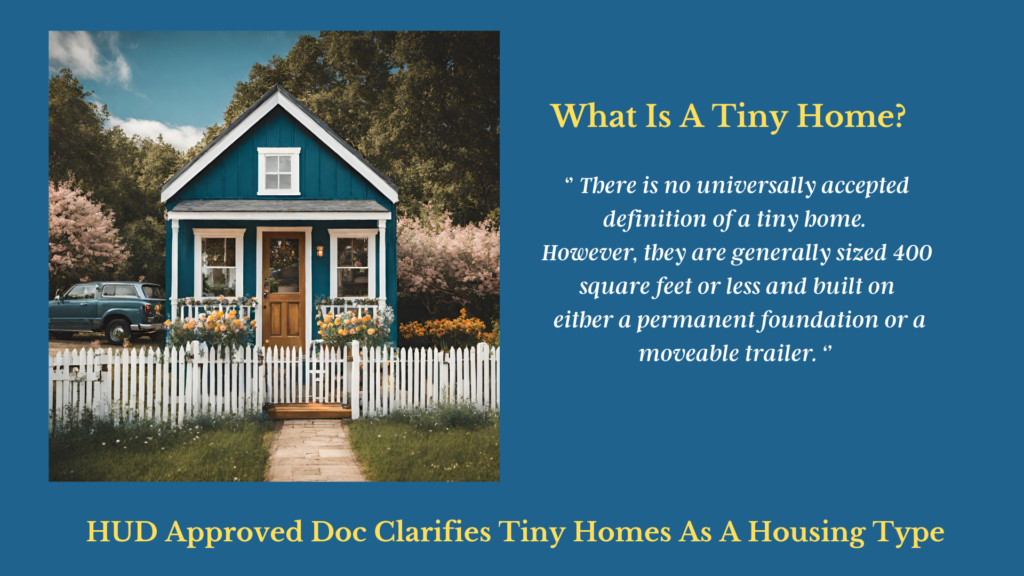Tiny Homes Are Generally Sized 400 Square Feet Or Less
I want to share an interesting document that was written by ICF and approved by HUD. The document is a guide to help educate housing counselors to guide their clients on all the different types of single-family housing types. What I appreciated the most was that tiny homes had their own classification, they were not swept under manufactured homes or modular, which have already had their own regulations and requirements established for decades, which comes with unfair stigmas, and over the top regulations that is adding to the housing crisis.
ASTM International has granted a subcommittee for tiny houses called E06.26 Tiny Houses within E06 Performance Of Building, and we have an opportunity to create standards for tiny houses that distinguish this housing type as its own industry.
Manufactured Home
Manufactured Home: Built in a factory to the Manufactured Home Construction and Safety Standards set by the
U.S. Department of Housing and Urban Development (HUD), known as the “HUD Code.” Homes are then
transported to the placement site. Each transportable section is identified as compliant with the HUD Code by a
red certification label permanently attached to the exterior.
Modular Housing
Built offsite in sections, which are transported to a site, assembled by builders, and installed onto a foundation. Built to
site, assembled by builders, and installed onto a foundation. Built to meet building codes and specifications of the site on which they are placed.
Mobile Home
Refers to factory-built, non-modular homes that were built before the HUD Code became effective on June 15, 1976.
Tiny Homes
There is no universally accepted definition of a tiny home. However, they are generally sized 400 square feet or less and built on either a permanent foundation or a moveable trailer.They may be purchased ready-made or built on site. A tiny home may be a Manufactured Home if it meets the HUD definition and is built to HUD code.
Site Built Home
Homes constructed on-site according to local building codes and regulations. The majority of homes in the U.S. are site built.
HUD Selects ICF To Support Community Development Programs
Company Will Build Capacity and Resilience for Communities
FAIRFAX, Va., Aug. 1, 2022 /PRNewswire/ — The U.S. Department of Housing and Urban Development (HUD) has awarded global consulting and digital services provider ICF (NASDAQ: ICFI) several new cooperative agreements to support its Community Compass and National Homeless Data Analysis Project programs. The combined agreements have a multimillion-dollar value and a term of three years.
ICF will provide capacity building, training, data analysis and technical assistance support to cities, counties, states and local nonprofits to implement effective community development programs and secure stable housing. The company will also continue to manage the HUD Exchange, a web-based platform for HUD community partners to access resources and assistance to help them implement programs. In addition, ICF will continue to provide capacity-building assistance to Community Development Block Grant Disaster Recovery (CDBG-DR) grantees to support their disaster recovery and mitigation programs.
Resources
The ICC/THIA Tiny Home Model Legislation
Another reason this HUD-approved document caught my eye is because of the 400 square footage footprint. On May 4th, 2022 ICC published new Model Legislation For Tiny Houses that was written by THIA and ICC to promote compliance to IRC codes and the two ICC/MBI standards 1200 and 1205.
This was published during the time that THIA and ICC were jointly fighting the ASTM Tiny House Committee from being approved.
What I never agreed with was the footnote about tiny homes and the HUD code and the 320 square foot print as stated;
” 1 Tiny houses on wheels with a permanent chassis over 320 square feet are subject to the Manufactured Home Construction and Safety Standards administered by the US. Department of Housing and Urban Development. Where these requirements apply, a manufacturer may opt-out if they then follow requirements equivalent to those contained in a model building code. ”
My opinion on the above footnote, is that HUD has not officially made a ruling on tiny homes and the statement is misleading and is not referencing official HUD documents. If a manufacturer builds to the HUD code, their factory would have to be HUD certified which is not cost effective for small manufacturers. There are bills and ordinances all over the country that define a tiny home in the footprint of 400 square feet or less.
The heart of the tiny house industry are small manufacturers and we need to keep costs at the forefront of our minds, because whatever costs that are passed on to the 3rd parties that certify them, they then pass that cost to the manufacturer, and then the consumer.
Tiny House Alliance USA Editor
March 16, 2024
The Future Of Tiny Is Now!
Janet Thome Founder And President
ja***@******************sa.org
509 345 2013



Pingback: HUD Approved Doc Clarifies Tiny Homes As A Housing Type - Tiny House Daily News